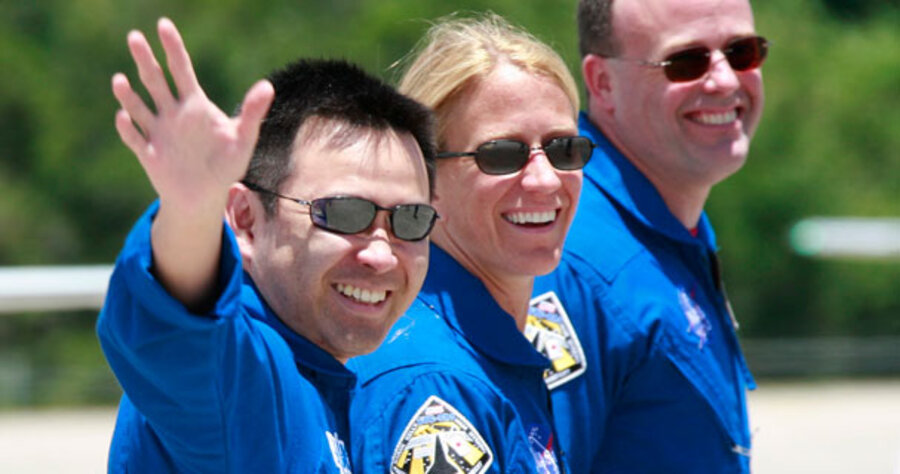Space station to get its largest lab
Loading...
US and Japanese astronauts are getting set to deliver the International Space Station’s scientific crown jewel, Japan’s “Kibo” laboratory, to the orbiting outpost.
Late Saturday afternoon, the space shuttle Discovery is scheduled for launch with the 16-ton lab module tucked in its cargo bay. If all goes well, the shuttle and space-station crews will install and activate the lab, as well as perform station-maintenance jobs, during 13 days on orbit.
A successful mission would represent a significant step for Japan’s space program, according to Akihiko Hoshide, one of four mission specialists on the shuttle crew and the mission’s payload commander.
“This is really a mission to make a dream come true,” he said during a press briefing earlier this month. For 20 years, teams in Japan have designed and built what US colleagues have dubbed a “beautiful piece of work.” For his country, he said, lofting the lab “is not the goal, it’s the beginning.”
One signal that the international partners – eager to put their labs to use – see light at the end of the modules comes in fresh recruitment campaigns for astronauts.
In April, the Japan Aerospace Exploration Agency (JAXA) announced it was accepting applications for astronauts, according to Masafumi Yamamoto, who heads JAXA’s liaison office at the National Aeronautics and Space Administration’s Johnson Space Center in Houston. “We look forward to receiving a lot of applications,” he says.
Canada and Europe have followed suit, announcing astronaut recruitment campaigns within the past two weeks. For now, however, the main focus is installing Kibo.
The 100-billion-yen module is the largest of the station’s labs, and boasts capabilities no other lab module duplicates. Like other lab modules, it will host racks of experiments inside. But Kibo also has been designed with an outside platform at one end for experiments requiring exposure to space.
Crew members can swap out experiments or samples on the platform using a robotic arm and a small airlock. And Kibo is the only lab with its own logistics module for storing experiments, samples, and spare parts. The logistics module arrived at the station in March during the last shuttle mission. Astronauts mated the logistics module at a temporary site then. Once Kibo is installed, astronauts will place the logistics module in its final location attached to Kibo before they wrap up their stay at the station.
Once the module is up and running, Japanese scientists plan some initial experiments with each of two science racks the module will initially hold, Mr. Yamamoto says. In 2009, with the first flight of Japan’s unmanned resupply capsule, more racks will arrive to expand the lab’s experiment capabilities.
With Kibo in the cargo bay, shuttle managers have had to modify the approach the shuttle crew takes to inspecting their ship for damage to the orbiter’s heat-shedding tiles. These protect the craft and crew from high temperatures generated as the orbiter reenters Earth’s atmosphere. In anticipation of a cargo bay full of Kibo, the shuttle crew had to leave a 50-foot extension to the orbiter’s robotic arm at the station. The extension gives the arm the extra length it needs to conduct inspections all around the orbiter, giving special attention to the leading edges of the wings.
Instead of conducting the exhaustive inspection on the second day on orbit, the crew will conduct the most thorough inspection it can without the extension, and make the usual orbiter back flip just before docking so station crew members can snap photos of the orbiter’s underside for engineers to scrutinize.
Then spacewalkers will reinstall the boom on the fourth day on orbit and conduct the detailed inspection after Discovery leaves the station. Then they get a day off while engineers on the ground analyze the data to ensure that the thermal-protection system will hold up under the rigors of reentry. If engineers find problems that would prevent reentry, the shuttle has enough propellant on board to return to the space station, where the crew could await rescue.
“It’s a pretty well-thought-out plan,” says Ken Ham, the shuttle pilot for this mission.
The inspection program is a legacy of the Columbia disaster in January 2003, when the orbiter broke up on reentry after ice from the external fuel tank damaged the thermal protection system during launch.
In that regard, delivering Kibo “is a milestone mission for the shuttle program” as well, says John Shannon, the space shuttle program manager. He notes that for the first time, an orbiter will launch with an external fuel tank built from the start with all of the modifications engineers have made to the design following the Columbia accident. And the mission, the 10th since the shuttles returned to flight in July 2005, means that only 10 flights remain before the space station is finished, stocked with some long-term spare parts that only the shuttle can carry, and the shuttle program ends in 2010.





